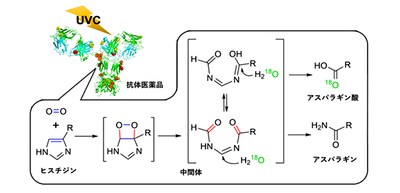
Reaction mechanism for UVC-induced oxidation of histidine in antibody drugs clarified
A group of researchers from Osaka University, Nara Women's University, and Panasonic Corporation has clarified the reaction mechanism involving a photo-induced concerted reaction of the imidazole group of histidine (His), an α-amino acid used in monoclonal antibody drugs, and singlet oxygen.
UVC irradiation, which causes protein degradation and modifications of amino acids, has been used for disinfection of microorganisms. Ultraviolet lamps with the strongest antimicrobial/antiviral properties are anticipated to be potent for sterilization or disinfection in the medical drug manufacturing scene; however, reaction mechanisms involving a photo-induced concerted reaction to antibody drugs were not well understood.
In this study, the researchers oxidized histidine residues in monoclonal antibody drugs of immunoglobulin gamma 1 (IgG1) by ultraviolet C irradiation and identified asparagine and aspartic acid in the reaction products using mass spectrometry. They also found that in the photo-induced oxidation of histidine in angiotensin II, 18O atoms from H218O in the solvent were incorporated only into aspartic acid but not into asparagine.
This suggests that UVC irradiation generates singlet oxygen and induces cycloaddition to form a dioxetane involving the imidazole bond of His, followed by ring-opening in the manner of further photo-induced retro cycloaddition. This yields an equilibrium mixture of two keto-imines, which can be the precursors to aspartic acid and asparagine.
This group clarified the effect of UVC irradiation in antibody drug manufacturing. Further studies on UVC irradiation will be applied in various fields such as inactivation of viruses using UVC irradiation.
Figure 1
The article, “Effect of UVC Irradiation on the Oxidation of Histidine in Monoclonal Antibodies,” was published in Scientific reports at DOI: https://www.nature.com/articles/s41598-020-63078-5.
Related Links
Uchiyama Laboratory, Graduate School of Engineering, Osaka University (link in Japanese)
